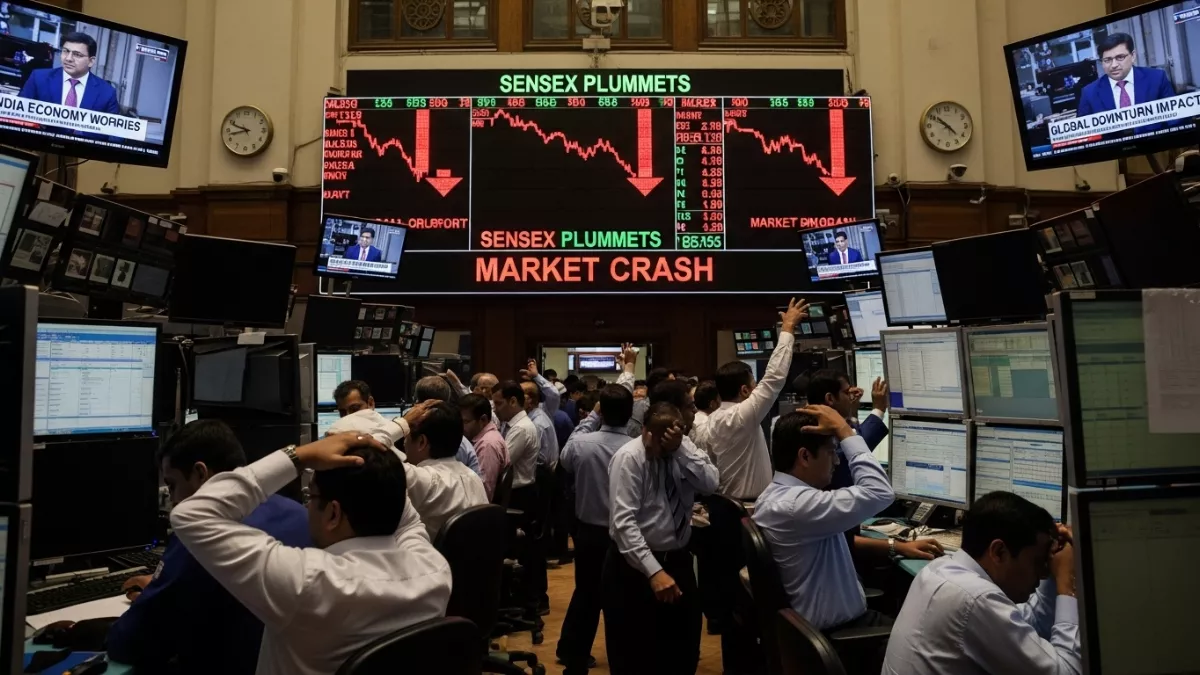
Why is the Indian Market Falling? — PuneRiPages.in explains the reasons behind the recent downturn in Sensex and Nifty.
By Prashant for PuneriPages.in
We have observed a persistent downturn in the Indian stock market in recent months, raising the question: why is the Indian market falling? To answer this, we must examine the combination of global headwinds, domestic vulnerabilities, sector-specific stresses, and investor psychology that together have triggered a broad-based sell-off.
Table of Contents
Global Rate Pressure and Foreign Capital Outflows
One of the most immediate drivers of the decline is the shift in global interest rates and the resultant withdrawal of capital from emerging markets. As the Federal Reserve signalled fewer rate cuts, foreign investor participation in Indian equities weakened significantly. With elevated wholesale yields in the U.S., emerging-market equity flows have reversed, placing pressure on indices such as the Nifty 50 and the Sensex.
India’s large reliance on foreign portfolio investment leaves it vulnerable to such global sentiment shifts. As foreign institutional investors (FIIs) turned net sellers, the domestic market lost both liquidity and confidence.
Stretched Valuations and Slowing Corporate Earnings
Another reason why the Indian market is falling lies in elevated market valuations outpacing corporate performance. Despite strong growth in prior years, analysts at institutions such as J.P. Morgan noted that earnings momentum for Indian companies has decelerated, undermining investor expectations.
This valuation-to-earnings gap has prompted investors to trim positions, leading to deeper declines when global cues turned negative. Domestic earnings disappointments have magnified the downside, making the market increasingly fragile.
Export & FX Risks Amid Global Trade Friction
India’s economy is deeply tied to global trade flows, and rising friction—such as imposition of higher tariffs and disruption of supply chains—has weighed on investor optimism. For example, sudden hurdles in export volumes and currency pressures have drained the equity market.
When the Indian rupee weakens in the face of global capital outflows, it raises concerns about inflation, import costs, and margin compression for key manufacturing and export-oriented companies, reinforcing the question: why is the Indian market falling?
Domestic Demand Weakness and Sectoral Stress
Slowing consumption, softness in manufacturing, and weak I-T demand are domestic factors that help explain the fall. In particular:
- The information-technology sector reported slower growth, triggering concerns about India’s export-led earnings model.
- Consumer-facing sectors were hit by inflation and slower urban demand, feeding into broader economic uncertainty.
- Banking and NBFC segments face stress from rising defaults and margin pressure, which ripple through market sentiment.
These domestic demand headwinds contribute to the narrative of declining growth prospects, exacerbating the equity market slump.
Technical Correction & Investor Sentiment Shift
From a technical perspective, the Indian market has entered a correction phase—marked by consecutive sessions of net selling and declining participation.
Retail investor exuberance that had supported valuations is now flagging, while margin pressures and option-expiries add to the volatility. A breakdown in sentiment tends to accelerate selling, prompting the question: why is the Indian market falling now, more sharply than might have been anticipated?
Regulatory Uncertainty and Macro Policy Risks
Regulatory or policy missteps can also prompt sharp downturns. India’s markets remain sensitive to fiscal deficits, interest-rate policy by the Reserve Bank of India and structural reforms. Unexpected policy announcements can spook investors, further undercutting confidence.
When the macro-framework appears under strain, market participants often sell first and ask questions later.
Implications for Investors & the Path Forward
Given the backdrop of why the Indian market is falling, what should investors do?
- Adopt a longer-term perspective: India’s growth story remains intact, but timing and valuation matter.
- Focus on companies with resilient cash flows, low leverage, and global diversification.
- Use volatility smartly: downturns can create entry points, but only if fundamentals are preserved.
- Monitor capital flows, corporate earnings trends and global rate cues closely—even more than headline indices.
Why the Indian Market is Falling — And What Comes Next
In summary, the Indian market’s decline can be traced to the interaction of global interest-rate shifts, foreign outflows, stretched valuations, export-luxury trade tensions, domestic demand softness and technical sentiment breakdown. While the headwinds are powerful, India’s long-term structural growth story still offers runway—provided investors are selective and disciplined.
Understanding why the Indian market is falling offers clarity amid turbulence. As global and domestic friction fades or structural reforms accelerate, the equity market may begin to recover—but until then, caution and insight will be the key for smart investors.





